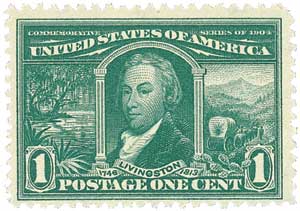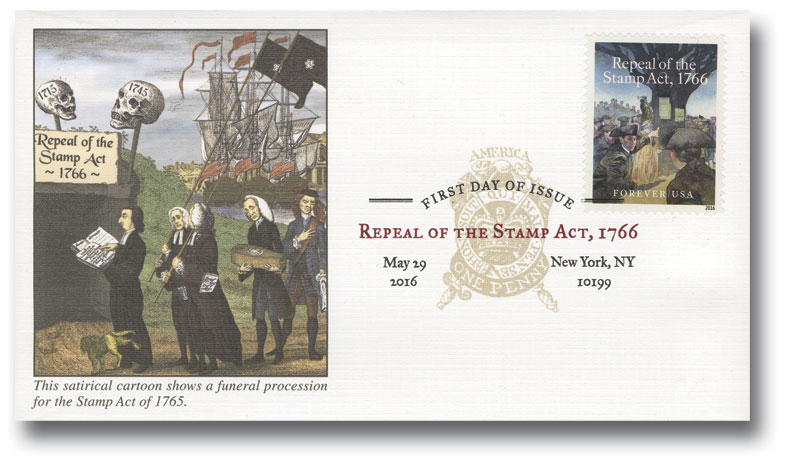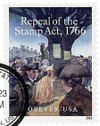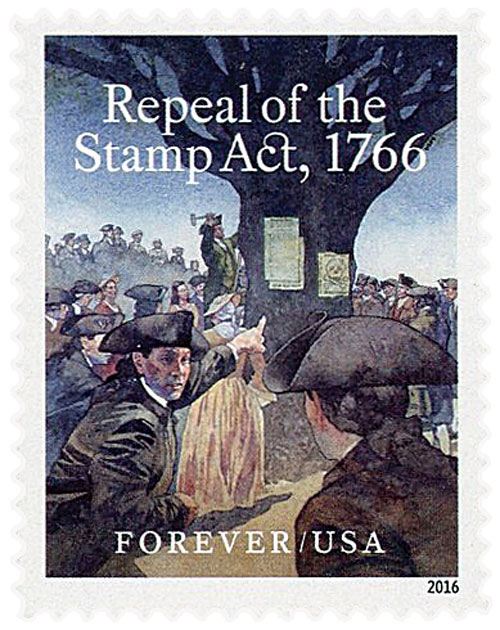
# 5064 - 2016 First-Class Forever Stamp - Repeal of the Stamp Act, 1766
Britain Repeals The Stamp Act
Britain first passed the Stamp Act on March 22, 1765, in an attempt to increase its revenues from the American colonies. This act placed a direct tax on the colonies for the first time. It forced colonists to buy a British tax stamp for every official document they obtained.
Under this act, all types of printed material required a stamp showing that a tax had been paid. Items requiring these stamps included newspapers, books, court documents, land deeds, almanacs, and playing cards.

Colonists were outraged and protested against taxation by Parliament, because they had no one to represent them. In response British goods were boycotted, customhouses were vandalized, and tax collectors were attacked. In England, merchants whose products were boycotted pressured Parliament to repeal the act.
The “Sons of Liberty” secret society was formed within the 13 colonies to coordinate protests. Effigies were burned under the “Liberty Tree” in Boston, and fear kept many tax distributors from selling the stamps.
That June, the Massachusetts Assembly sent a letter to the various colonies (including portions of present-day Canada, which was then known as the British West India islands) to arrange a meeting to discuss the situation. Nine colonies (Massachusetts, Rhode Island, Connecticut, New York, New Jersey, Pennsylvania, Delaware, Maryland, and South Carolina) ultimately selected delegates to attend the congress. Among the delegates were some familiar names: Robert R. Livingston and Caesar Rodney.

The delegates met in New York City in the fall of 1765 behind closed doors. They debated the differences between direct internal taxation and external taxation from Britain. In the end, they largely agreed that taxation should remain within the colonies.
The delegates produced a statement of rights to send to the king and Parliament. Known as the Declaration of Rights and Grievances. Many in England refused to recognize the document and considered it inappropriate and unconstitutional. However, the threat of lost trade led some to rally for the repeal of the act.

British Parliament ultimately voted 276-168 to repeal the Stamp Act on March 18, 1766. But they also passed Declaratory Act, which claimed its authority to legislate the colonies no matter what. The decision slowed calls for independence, though it did not stop the march toward the American Revolution. But the die had been cast. Flush with victory, colonists would soon use their Stamp Act protest tactics to push for true independence.
Britain Repeals The Stamp Act
Britain first passed the Stamp Act on March 22, 1765, in an attempt to increase its revenues from the American colonies. This act placed a direct tax on the colonies for the first time. It forced colonists to buy a British tax stamp for every official document they obtained.
Under this act, all types of printed material required a stamp showing that a tax had been paid. Items requiring these stamps included newspapers, books, court documents, land deeds, almanacs, and playing cards.

Colonists were outraged and protested against taxation by Parliament, because they had no one to represent them. In response British goods were boycotted, customhouses were vandalized, and tax collectors were attacked. In England, merchants whose products were boycotted pressured Parliament to repeal the act.
The “Sons of Liberty” secret society was formed within the 13 colonies to coordinate protests. Effigies were burned under the “Liberty Tree” in Boston, and fear kept many tax distributors from selling the stamps.
That June, the Massachusetts Assembly sent a letter to the various colonies (including portions of present-day Canada, which was then known as the British West India islands) to arrange a meeting to discuss the situation. Nine colonies (Massachusetts, Rhode Island, Connecticut, New York, New Jersey, Pennsylvania, Delaware, Maryland, and South Carolina) ultimately selected delegates to attend the congress. Among the delegates were some familiar names: Robert R. Livingston and Caesar Rodney.

The delegates met in New York City in the fall of 1765 behind closed doors. They debated the differences between direct internal taxation and external taxation from Britain. In the end, they largely agreed that taxation should remain within the colonies.
The delegates produced a statement of rights to send to the king and Parliament. Known as the Declaration of Rights and Grievances. Many in England refused to recognize the document and considered it inappropriate and unconstitutional. However, the threat of lost trade led some to rally for the repeal of the act.

British Parliament ultimately voted 276-168 to repeal the Stamp Act on March 18, 1766. But they also passed Declaratory Act, which claimed its authority to legislate the colonies no matter what. The decision slowed calls for independence, though it did not stop the march toward the American Revolution. But the die had been cast. Flush with victory, colonists would soon use their Stamp Act protest tactics to push for true independence.









